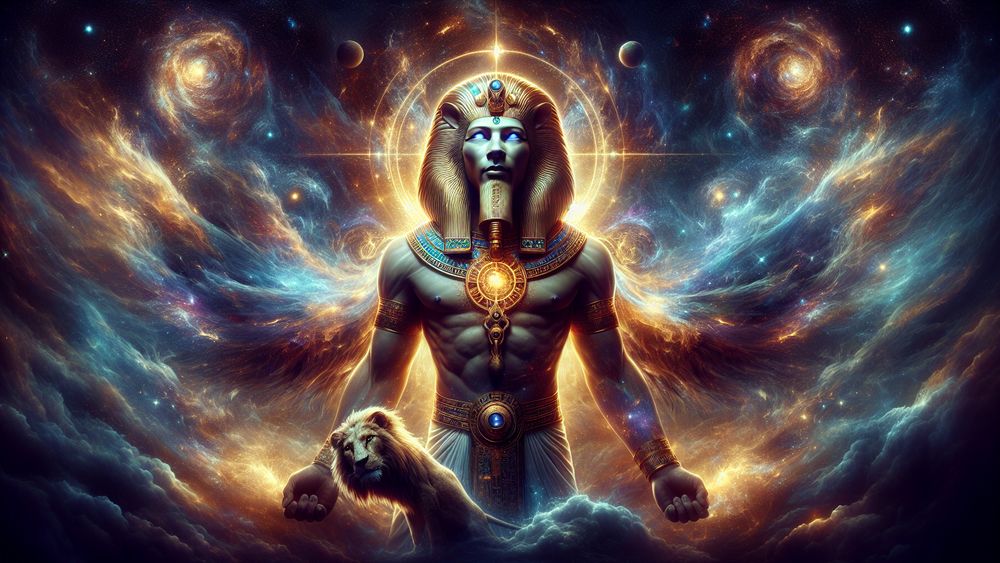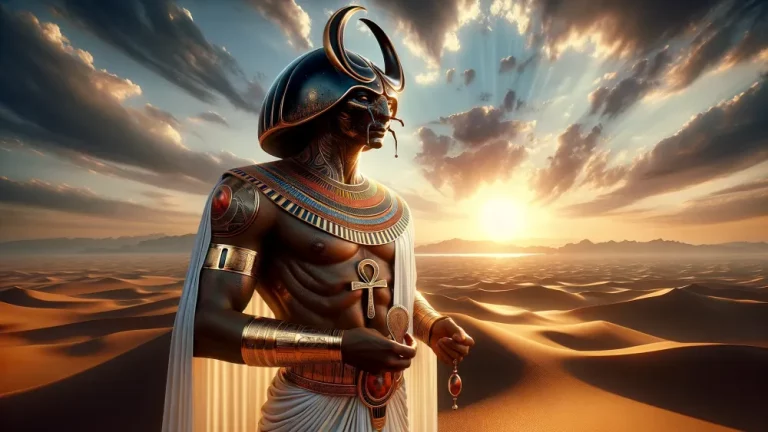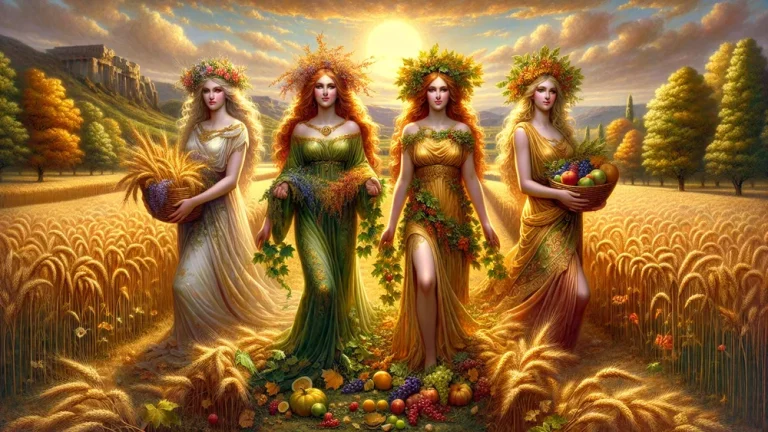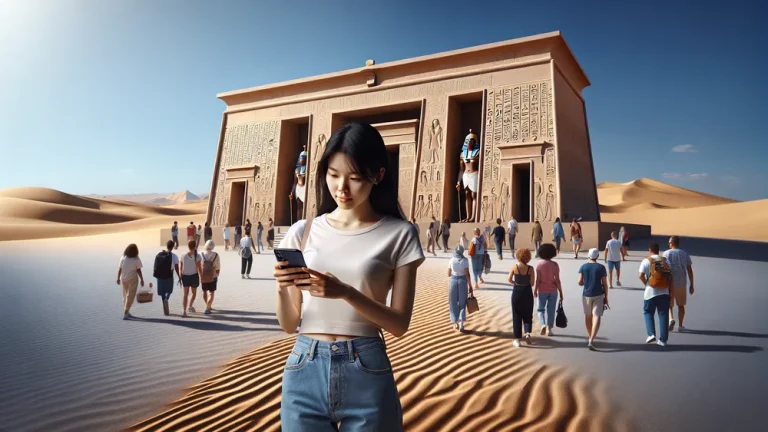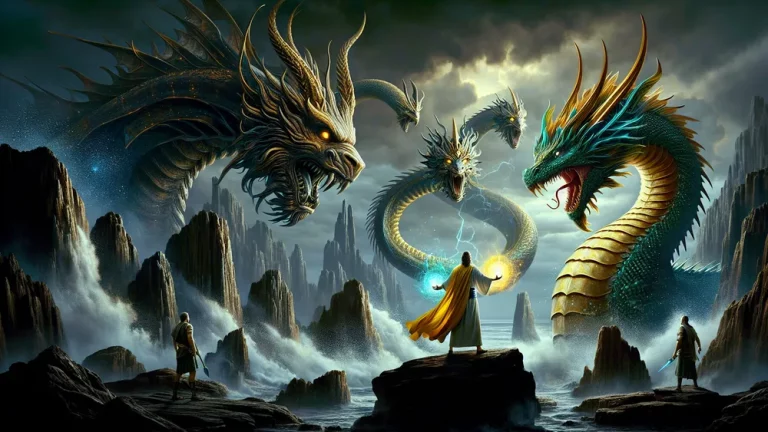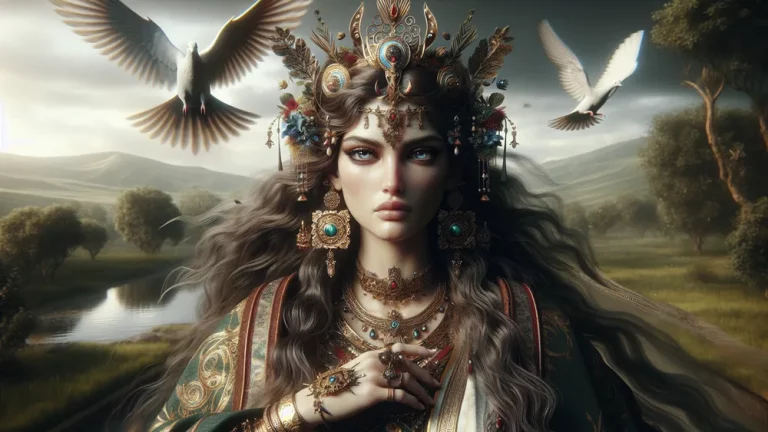Atum’s Creation Story: How Did Atum Create The Universe
In ancient Egypt, stories that explain how everything began are very much a key part of their culture. These stories are like the roots of a tree for their beliefs and ways of thinking. At the center of these tales, we find Atum. He’s a god whose story about making everything is both special and full of interesting points. This story does a lot. It doesn’t simply tell us where the universe came from.
Key Points:
- Atum, an ancient Egyptian god, creates the universe and other gods by self-creation.
- Atum emerging from chaos symbolizes the start of order and creation.
- Atum’s creation of Shu and Tefnut brings structure and balance to the universe.
- Atum’s role in the Egyptian pantheon links him to creation and the sun god Ra.
- Atum is symbolized by the scarab beetle and worshipped at the Great Temple of Atum in Heliopolis.
- Egyptian mythology features various creation stories, each emphasizing different aspects of creation and divine beings.
- Atum’s act of self-creation influences Egyptian culture by emphasizing intention and willpower in creation and life.
It also lets us see the world through the eyes of the ancient Egyptians and understand their place in it. By looking into how Atum brought everything into being, we really get to see what the ancient Egyptians thought about life, creation, and the endless cycle of life and death. These ideas were super central to their way of seeing the world.
The Origins of Atum in Egyptian Mythology
So, let’s kick this off by heading straight to where everything begins, with Atum. He’s like the starting point for all that exists.
Who is Atum?
So, Atum, right? He literally makes himself. No help needed. He’s at the very start of everything in Egyptian stories about gods and the world. Picture him there, at the center, because that’s where he fits. He kicks off everything, which is a pretty big job. He’s got this massive power and knows a lot, which lets him create other gods and even people.
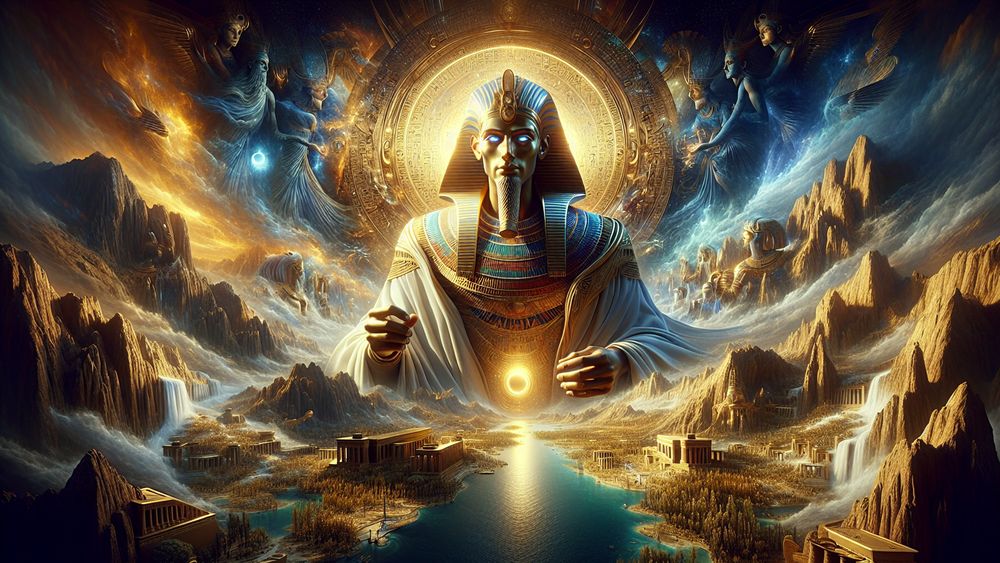
Plus, he manages all the elements and keeps the world running smoothly.
- First off, people often show him as a man and a snake. This means he can make himself over and over.
- Then, he’s got this connection to the sun and the earth. It’s like he’s got a foot in both worlds, which talks about how he can make and unmake.
- Lastly, when it comes to afterlife business, Atum’s your guy for protection for those who’ve passed on.
So, yeah, Atum is a pretty major player in the Egyptian god scene.
Atum plays a crucial role in Egyptian mythology as the self-created creator god who initiates and oversees the functioning of the world and afterlife.
The Concept of Creation in Ancient Egypt
In ancient Egypt, people see the universe and its beginning as closely tied, where what we can touch and the divine directly connect. This view shines through their stories of how everything began which, while they all agree that everything started from chaos and darkness, differ a lot in who did what and where. The story from Heliopolis about Atum is all about him making himself and then making other gods.
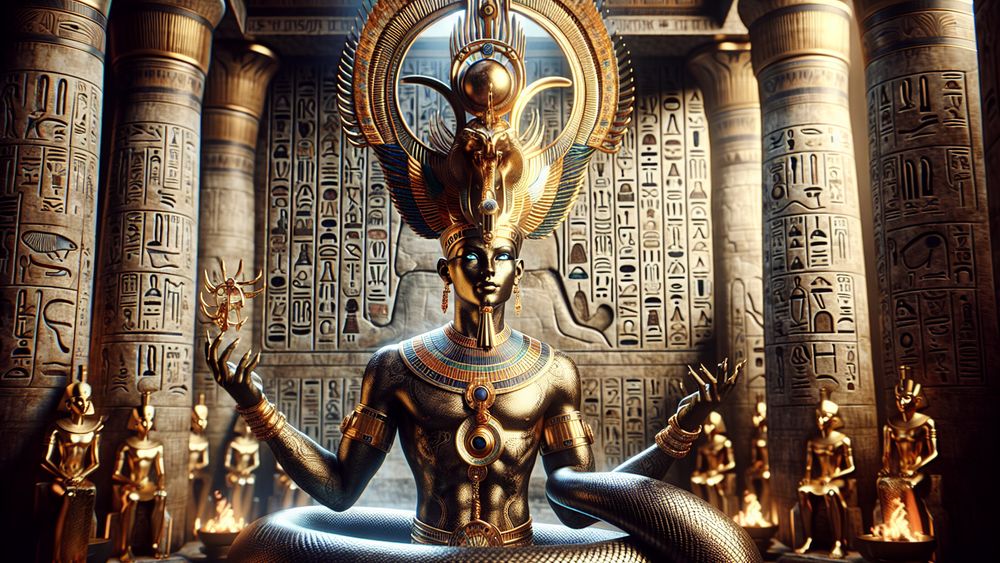
This is quite different from the Memphis story where Ptah makes everything with his thoughts and words, or the tale of the Ogdoad in Hermopolis which involves eight very old gods. These different stories show how Egyptian mythology is both complex and full of variety, offering many ways to understand how everything started and where life came from.
Atum’s Process of Creating the Universe
So, we’ve wrapped our heads around the ancient Egyptians’ creation views and pinpoint where Atum slots into this narrative. Now, let’s shift our focus and really hone in on the specifics of how Atum goes about crafting the universe.
The Emergence from Nu (Chaos)
So, let’s talk about when Atum steps out from the so-called primordial waters of Nu. Picture this: before anything else exists, there’s this endless, dark water everywhere. That’s Nu for you. It’s all about chaos and having no form at all. Then, boom, Atum makes his grand entrance. He doesn’t come from a group of gods or through some battle.
No, it’s all him, directly from the chaos, which is pretty unique when you think about it. Now, Atum finds himself on this mound that’s popped up out of nowhere. This mound is literally the first bit of solid ground ever. Him standing there is a huge moment because it means so much more than simply “here’s some land.”
It’s about order coming out of nowhere, life kicking off, and setting a fixed point for everything else to follow. It’s like Atum is saying, “Okay, let’s start from here and see where we go.” This whole scene where he’s standing on the mound is about making sense and structure out of a total mess.
- Nu literally equals the idea of a never-ending ocean that you find in lots of other stories about how the world starts.
- The primordial mound where Atum plants his feet is sometimes called Benben, which later on people link to those pointy stones or mini pyramids that mean “the very first hill.”
- Him popping up and standing there marks the very first morning which keeps popping up in Egyptian pictures and symbols as a sign for starting fresh and new beginnings.
Atum’s emergence from chaos onto the primordial mound symbolizes the creation of order and the beginning of life, setting the stage for future developments and new beginnings.
The Act of Self-Creation and Its Implications
So, Atum does something quite unusual. He literally makes himself. No help needed. This idea is a big part of what Egyptians think about where everything comes from. It’s like Atum decides, “I’m going to exist now,” and so he does. This tells us that the start of everything was on purpose, because of a decision, and that’s a huge idea for the people back then.
They see their gods as super powerful because they can simply decide to be. Also, this whole making oneself happen thing? It really gets the Egyptians thinking about how being alive and the world around them isn’t random at all. It’s all about intention and willpower.
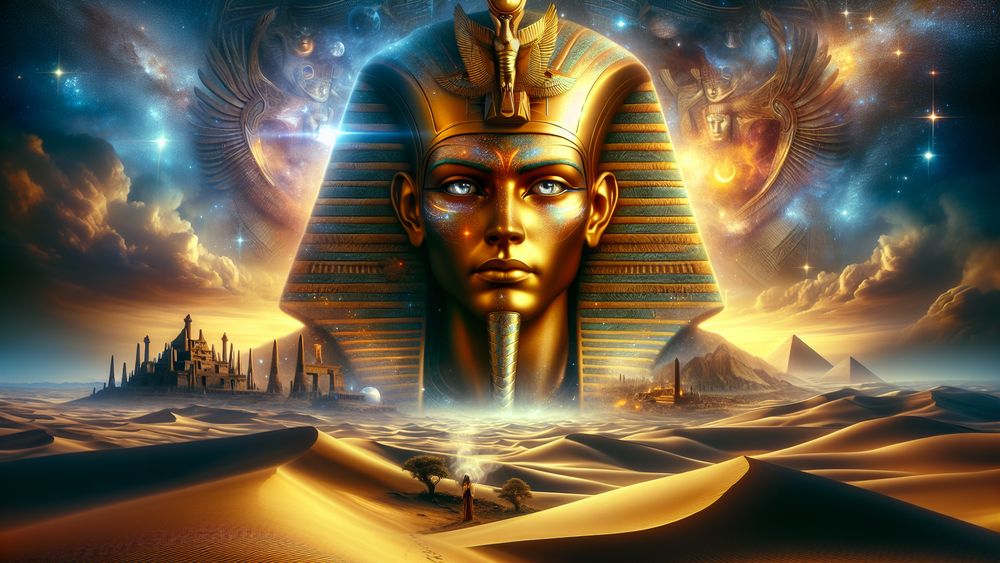
Gods have this amazing ability to be self-sufficient which really matters in how people worship them and how they run their society. So, when we talk about Atum and his self-creation, it’s a way to understand that for Egyptians, the very essence of life and the universe is all about taking action and making decisions.
The Creation of Shu and Tefnut
So, after Atum comes into being by himself, he doesn’t stop there. Nope. He goes on to create two very crucial deities, namely Shu and Tefnut. Shu takes on the role of air and literally carries the sky, while Tefnut brings moisture and rain into the mix.
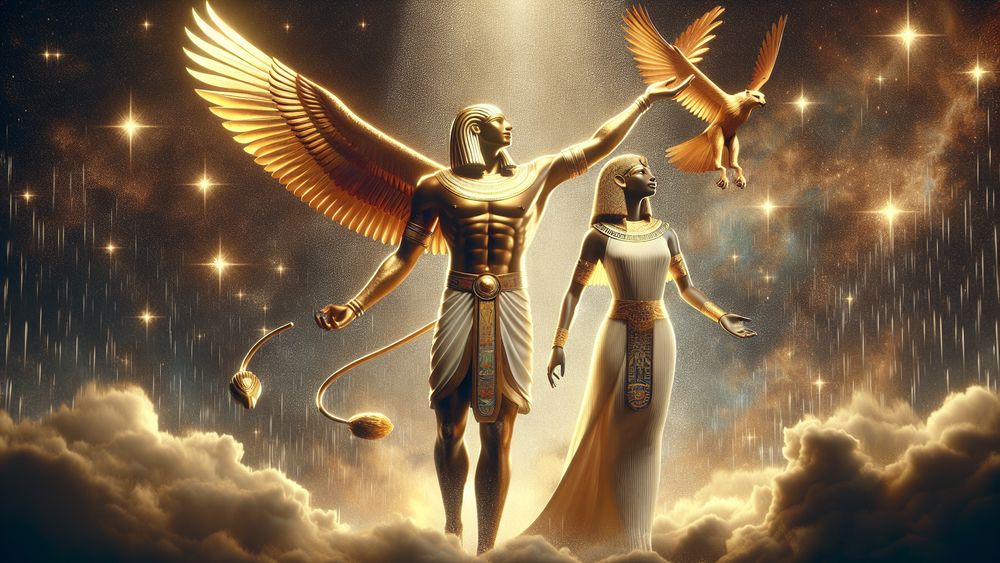
This moment is huge because it’s when life and a sense of order start to bubble up in the universe. By bringing Shu and Tefnut into existence, Atum essentially moves from nothing and chaos to something much more structured and balanced.
It’s like setting the stage for a world where life can actually happen, governed by rules and the natural order of the universe. Now, when we talk about Shu and Tefnut’s impact, it’s pretty massive. Shu deals with air and creates the necessary space between the sky and the earth, which is absolutely needed for creation to grow and diversify.
On the other hand, Tefnut is all about moisture and water, which, as we all know, is critical for life and growth. Their roles are so foundational that they pave the way for everything else that follows in the Egyptian creation story, especially when it comes to establishing Ma’at, which is all about balance and order in the cosmos.
Thus, Shu and Tefnut are key players in moving from a chaotic state to an ordered universe where life thrives and gods play their part. Table: Roles and Significance of Shu and Tefnut
| Deity | Element | Role in Creation | Significance |
|---|---|---|---|
| Shu | Air | He separates and supports the sky from the earth | He makes space for creation to grow |
| Tefnut | Moisture | She provides the conditions needed for life | She helps life grow and keeps it going |
The Legacy and Worship of Atum
So, after we’ve dug into how Atum crafts the universe, we pivot. Now, we’re heading into a space where we look at how people back then lift him up and keep his story alive.
Atum’s Role in the Egyptian Pantheon
So, let’s talk about Atum and where he fits into the Egyptian pantheon. He’s super early in the game and packs a lot of power. His connections with other gods? They’re pretty layered and interesting because he’s basically the starting point. He’s the dad of Shu (air) and Tefnut (moisture) which puts him right at the center of the divine family tree.
This connection makes him a key player in both kicking off and keeping the universe running. As time marches on, people start to see Atum in a new light, especially when they start to blend him with Ra, the sun god. This mash-up creates Atum-Ra, which is like saying he’s the whole cycle of the sun – down and up.
It really shines a light on how Atum does double duty: he gets the ball rolling and makes sure it keeps moving. This blending thing that happens? It really goes to show how flexible Egyptian beliefs are. Gods can come together but still keep their own tags and jobs within the pantheon.
Atum occupies a central role in the Egyptian pantheon, being the progenitor of key deities and evolving into Atum-Ra, which illustrates his dual function of initiating and sustaining cosmic processes while demonstrating the adaptability of Egyptian religious beliefs.
Symbols and Temples Dedicated to Atum
So, when we talk about Atum, this deity gets linked with the scarab beetle quite a bit. Why? Well, because this little creature has a habit that looks a lot like rolling the sun across the sky if you think about it literally, which ties back to creation and the sun itself. Also, there’s the serpent which people connect with Atum too.
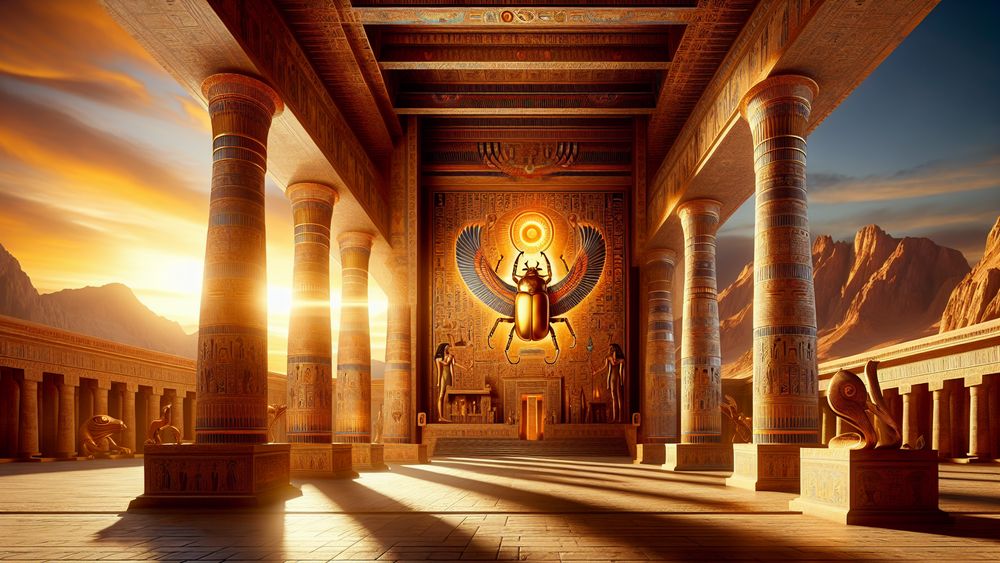
This creature brings to mind the idea of something formless and chaotic which is pretty much how everything started before Atum got to work. These symbols really nail down Atum’s job as the one who kicks off life and keeps it going. Now, if we shift our focus to where people celebrated Atum, Heliopolis takes center stage.
This place is thought to be where that very first piece of land popped up for Atum to start creating. It’s where you’d find the Great Temple of Atum, which was a huge spot for people to come and show their respect and keep up with all the stories and teachings about Atum and where he fits into the bigger group of Egyptian gods.
This temple and its leaders had a really key role in making sure everyone knew about Atum’s stories and his importance, which made Heliopolis an essential place for anyone interested in the spiritual and religious life back in ancient Egypt.
Pantheon of All the Egyptian Mythology Gods
So, when we talk about Egyptian mythology, it’s like opening a huge book where each page introduces a new god or goddess. These beings, each with their own special powers and stories, really show what the ancient Egyptians thought was super-important.
If you’re curious and want to know more about these divine characters, there’s a place where you can find info on both the well-known and the less famous ones. Just click here for a detailed list of all the Egyptian gods. It’s pretty straightforward and gives you the scoop on the gods that fill up the Egyptian mythological universe.
FAQs
1. How did Atum differ from other creator gods in Egyptian mythology?
In Egyptian mythology, Atum sets himself apart. He does this by being the one who brings himself into existence. Then, he kick-starts the universe and the birth of other gods, all on his own. He acts and decides with purpose. This makes him unique. Other gods, they come into the story through different means. But Atum, he starts it all.
And that’s how he’s different.
2. What are the main symbols and animals attributed to Atum?
Atum connects with two main symbols. First, we see the scarab beetle. It directly ties to the idea of bringing life into being. Then, there’s the serpent. This one leans into the concept of forever, without end. Both carry heavy weight in their meanings, yet they do so simply and clearly.
3. How did Atum’s act of self-creation influence ancient Egyptian culture and religion?
So, when Atum decides to bring himself into existence, it really shakes up how people in ancient Egypt think about where everything comes from. They see him as this super powerful being who doesn’t need anyone else to start the ball rolling. This idea, it kind of sets the stage for everything else in their beliefs and practices.
They start seeing unity and the power to create as something very central, something that’s part of life itself. And so, because of Atum and his unique way of coming into the scene, folks back then really lean into the idea that there’s this ultimate creator who’s got everything under control.
4. Can you explain the significance of Shu and Tefnut in Atum’s creation story?
So, in the tale where Atum starts everything, Shu and Tefnut really matter because they are air and moisture. These two, you see, they’re crucial for life to kick off and keep going. They literally mark when everything began to get into some sort of order.

